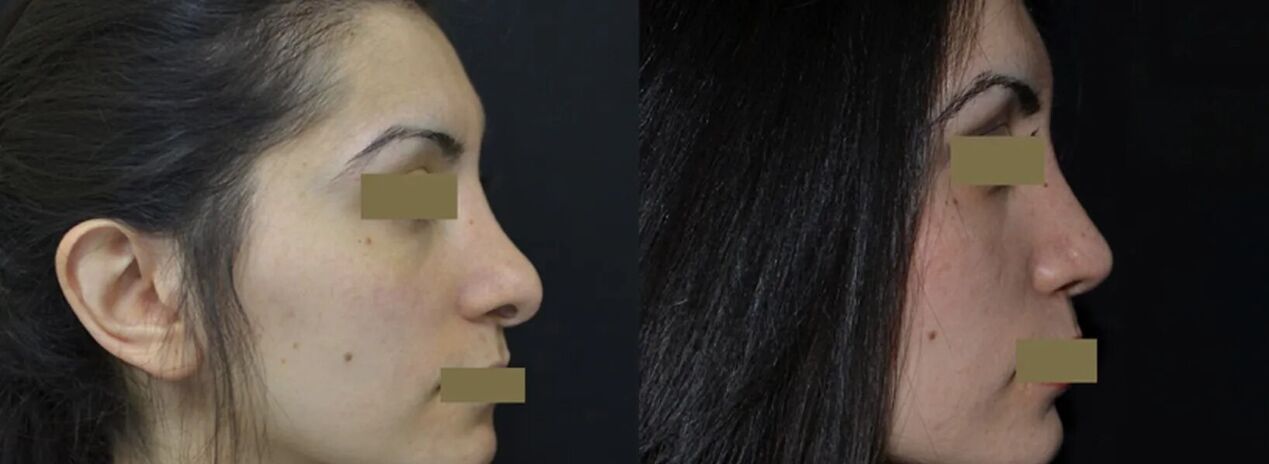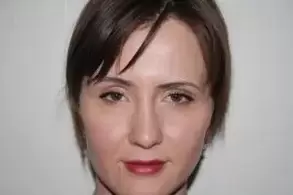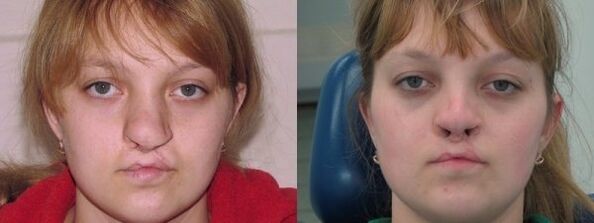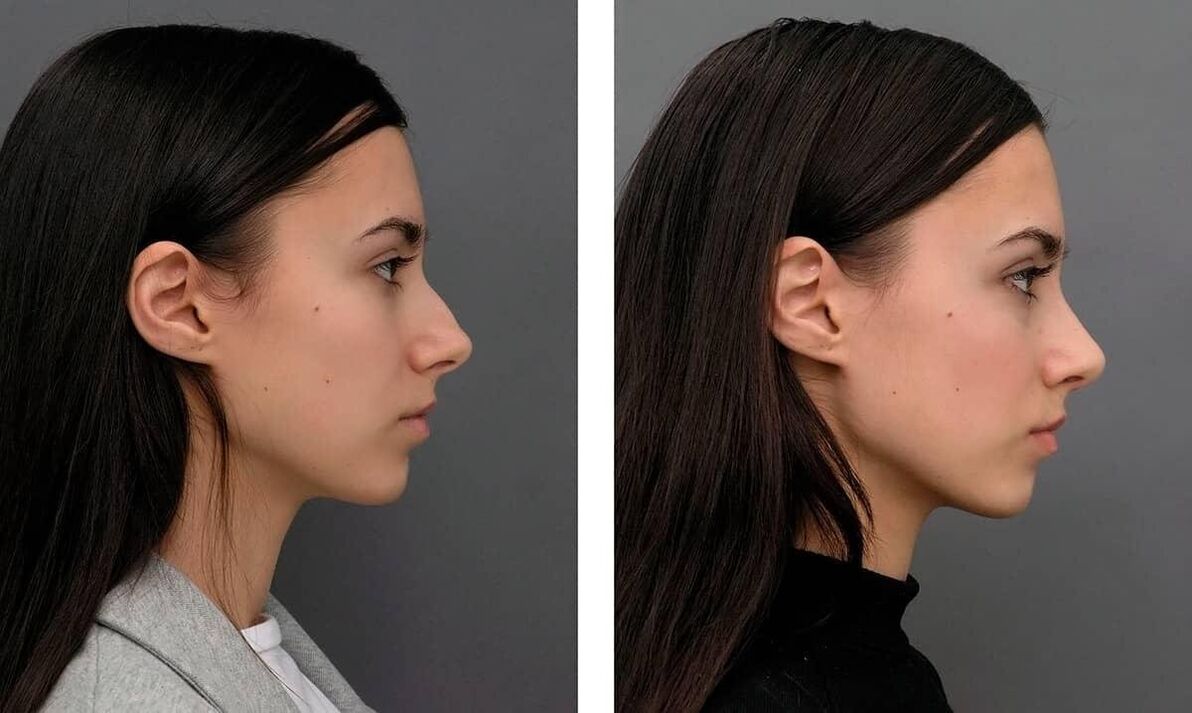Revision rhinoplasty is an operation aimed at correcting unsuccessful results after plastic surgery, which has already been performed for nasal correction. After rhinoplasty, revision rhinoplasty is the only option for patients with significant deformities or functional disorders of the external nose. Thus, sometimes after rhinoplasty, patients notice abnormal differences or noticeable asymmetry of the nasal wings. Sometimes a snub nose turns into a "saddle" nose - with the back of the nose too low, because the surgeon removes too much bone or cartilage tissue.
It also happens that the reason for the patient's dissatisfaction may not be related to the technique of the operation, but to the individual characteristics of the organism. For example, after healing, the scar on the columella becomes large and noticeable. The nasal wall is more prominent and visually elongates the nose as a result of a tendency for unexpected growth of scar tissue or incorrect operation. Revision rhinoplasty allows to solve such problems and restore the natural proper shape of the nose, restore the respiratory functions of the nose, restore the patient's self-confidence and attractiveness.
Secondary rhinoplasty - approaches and methods
As a rule, patients who apply for secondary rhinoplasty are disappointed, cautious people and have little faith in the success of the second operation. During the consultation, we try to collect a comprehensive medical history and photographs before rhinoplasty to understand what manipulations were performed and in what structures of the nose. We recommend that such patients undergo an MRI before a revision rhinoplasty - an analysis of this information will allow us to create an objective picture of the internal structures of the nose, develop an operation plan and agree with the patient on the possibility of revision rhinoplasty.
Crooked nose after rhinoplasty
One of the main complaints of patients is a crooked nose after rhinoplasty, the tip of the nose is not elegant enough, there are bumps or depressions in the back of the nose. Sometimes a nose contour may be recommended to correct minor imperfections. Unfortunately, large defects can be corrected only during the second operation.

Sometimes the situation allows you to do without a second operation, for example, in the case of extremely convex scars, to take advantage of drug treatment. To correct small asymmetries, we recommend the use of non-surgical rhinoplasty - the use of fillers or drugs containing botulinum toxin to rotate the tip of the nose. More often, however, surgical correction is still required, such as transplanting its own cartilage tissue to fill the saddle-shaped depression, or restoring the shape of the nasal alae by rotating the tip of the nose and correcting the condition of the nasal septum. and nasal cartilage.
The possibility of re-rhinoplasty can be discussed only 6-8 months after the first rhinoplasty. This is due, firstly, to the fact that the final recovery of tissues takes a long time, the shape of the nose changes within a few months after surgery, and the "defects" observed by the patient immediately after plastic surgery disappear. completely over time. In addition, surgery, even if minimally invasive, always causes more or less damage to tissues and nerve endings - so you need to wait for a full recovery before performing a second operation.
The latest methods for rhinoplasty using micro-instruments are such that the consequences of any failed operation can be eliminated. The key is to seek help from a qualified professional.
Causes of complications: the surgeon's mistake or the patient's fault?
It would not be right to put all the blame on the patient, but it would be a big mistake to blame the plastic surgeon for everything. The reason for a defect can be both the low qualification of the specialist and the patient's careless attitude to the recommendations received. In some cases, "crooked nose" and other complications of rhinoplasty are associated with the unfavorable course of the recovery process, and in this case no one can be blamed.
And again, the mistakes of plastic surgeons can actually cause nasal deformity after rhinoplasty. Therefore, special attention should be paid to the choice of specialist and clinic. You can not choose a doctor at "low prices", health and beauty can be entrusted only to an experienced master of his craft. Otherwise, you will most likely have to pay twice.
The following are some of the mistakes that plastic surgeons can make and the aesthetic complications that rhinoplasty can bring:
Proper placement of grafts. Transplantation of autologous material (patient's cartilage tissue) or implantation of synthetic implants is very often used in the reconstruction of the nose. If the location of the implants is asymmetrical, the patient will see a "curved nose" and obvious asymmetry after the tissue has healed.
asymmetric correction. Many rhinosurgery procedures involve interference with the bone and cartilage elements of the nasal skeleton, including resection of a portion of the hard tissue. If the resection is performed unevenly on the right and left sides, curvature and asymmetry of the nose appear after rhinoplasty.
As already mentioned, the development of aesthetic complications after rhinoplasty is not always the result of the surgeon's mistake or the patient's irresponsibility during the rehabilitation phase. The following are the causes of complications that can be called the result of unfavorable situations:
transplant extrusion. Tissue or implant transplantation is used in many rhinosurgeons. Unfortunately, the implant can move during the recovery period. The result will be a curvature of the nose or its asymmetry.
Resorption of cartilage graft. Cartilage graft is a living tissue that is exposed to body enzymes. With the unfavorable course of regenerative processes, part of the graft can be destroyed by enzymes. The result will be a "crooked nose" or a violation of the symmetry of the right and left halves.
Deformation of the cartilage graft. Distortion is a Latin word that translates as "curvature". Cartilage is elastic and flexible. Deformation may occur under the pressure of other anatomical formations of the nasal skeleton, as well as due to severe tissue edema. This will result in a crooked nose.
Disorders of the integration of bone and posterior cartilage. During the operation, the connection between the bone and cartilage elements that make up the back of the nose is broken. If there is no proper integration of these structures during rehabilitation, a gradual deformation develops.
Excessive growth of callus. The process of bone regeneration involves the intermediate stage of bone callus formation, which will then be replaced by full-fledged bone tissue. If the regenerative processes are very active, there is a lot of tissue from the outside, which manifests itself in a bump, "bump" or asymmetry. There may be a deviated septum.
Hypertrophy of scar tissue at the tip. In the area of the tip of the nose, or more precisely, directly above the tip, as a result of abnormal growth of scar tissue, there is an excess of tissue, which manifests itself externally as a coracoid deformity.
It remains to list some of the errors of the rehabilitation period that can lead to curvature and deformation of the patient's nose:
- wear glasses;
- displacement or self-removal of gypsum fixative;
- spontaneous removal of rhinological tires (tampons in the nasal passages);
- accidental mechanical damage to the nose;
- sneezing with closed mouth;
- to blow;
- to drink alcohol and smoke during rehabilitation;
- early recovery of the sport.
The results of such an operation
Rhinoplasty is an expensive, complicated and sometimes necessary operation. What do you need to know about the results?
When deciding on such an operation, you should know that the procedure is fraught with complications. It is not that there are inevitable natural difficulties in any field of operation, they pass after a certain period of time. These include: hematomas, bruising under the eyes, difficulty breathing, sense of smell, temporary asymmetry, numbness.
What could be the reason for this?
- Violation of the rules of preparation and conduct during the recovery period,
- Individual characteristics of a person.
The end result is known only after a year, sometimes a little later. No doctor can accurately predict this.
Complications after rhinoplasty
Complications after rhinoplasty can be classified as follows:
- aesthetic,
- functional,
- Psychology.
The last point is slightly different, it stems from the previous two points. But sometimes it is especially different, because it can continue in a complex form, depending on the level of the main complication and the psyche of each individual. Similarly, functional complications can leave a mark on point 1 (aesthetic), because all functional disorders also have external manifestations.
Results of rhinoplasty
Frequency of occurrence
Complications arise throughout the operation and. They can be divided into 4 rounds:
- During direct surgery, more often severe blood loss,
- Immediately after surgery
- During the recovery period
- At the end of the rehabilitation period.
In addition to bleeding, complications include rough scars, adhesions, bone damage, airway obstruction, bruising and.
Expected and unavoidable complications pass within 2 weeks. The danger is "unexpected" complications:
- infection,
- tissue necrosis (skin, cartilage, bones),
- Differences in seams (easily removed).
Let's look at some complications in more detail.
Species
Edema
Swelling after rhinoplasty is a natural phenomenon. It would be wrong to call it a real complication. Edema appears in the area of operation and under the eyes. It is clearly visible immediately after the operation. It falls in about two weeks. The swelling can last longer - up to six months. The reasons for the duration and quality of edema are strictly individual.
callus
If the operation requires the destruction of bone structures, the formation of bone callus can not be prevented. Its existence is the norm. One complication is hyperthyroidism. Such a complication leads to deformation of the nose, a violation of harmony.
Callus formation after rhinoplasty is a natural process that protects the body from external influences. This is the process of bone regeneration. First new connective tissue is formed, then thin bone fibers are formed, and finally the bone tissue completely replaces the soft tissue. The surgeon's task is to prevent the intensity of this process.
The nose is bent to the side

What was the purpose of the operation? If the reason was to eliminate the curvature of the nose, immediately after the operation, the result may be pleasant, the curvature disappears. However, by the end of the rehabilitation period, it may return because there is no "memory" in the nasal tissues. In this case, adjustment is required.
But swelling can also be the cause of curvature. In this case, it is a natural complication that will disappear at some point. Here again, individual characteristics play a role. For some, the period will be 2 weeks, for others - a month, two, three.
In any case, such curvature will be the norm. If the problem persists, you can talk no later than a year.
The nose does not breathe
Obstruction of the nasal passages after rhinoplasty can lead to nasal breathing disorders. This usually happens during rehabilitation. The cause of the complication is allergic or reciprocal rhinitis. This requires medical treatment. Surgery is needed only when treatment fails.
With delayed complications (occurring after a long time), there may be narrowing of the nasal passages, which makes it difficult to breathe through the nose. This creates a feeling of anxiety. In this case, reconstructive surgery is required, because the cause of the complication is an increase in the amount of tissue in the inner part of the nasal cavity. It needs to be cut.
Swinging nose
This complication is called a "gap". The reason is a deformity caused by a fracture of the skull during an osteotomy, in which the fragments can not be centered. The reason may be an excessive seal on the nose. Corrected only by repeated osteotomy.
Bad smell
Unpleasant odor in the nose after rhinoplasty is a natural phenomenon. It is not a complication and is acceptable for the entire first year after surgery.
Temperature
After rhinoplasty, the body temperature rises, which is normal. Does not last more than 3 days. In other cases (high temperature, prolonged) you should consult your doctor.
Other complications

After the operation, the sense of smell is disturbed, which is quite natural. It will gradually return to normal. has a red or pink color. Not only that, they tend to grow.
To eliminate them, the surgeon must meet all the necessary requirements during the recovery period:
- Treatment of stitches with drugs prescribed by a doctor,
- Keloid scars require corticosteroids
- In some cases, corrective surgery may be prescribed.
Although rhinoplasty is very common, it is a serious operation. What matters is not only the experience of the specialist, but also your attitude to the procedure. Negligence is unacceptable. You must fully trust the surgeon and fulfill all the necessary requirements. Of course, the qualifications of a specialist should not be in doubt.
It is no secret that facial imperfections create a biased public opinion that is important for people's self-esteem. Loss of attractiveness often leads to depression. That is, it is logical that facial deformities that reduce symmetry reduce patients' quality of life and self-esteem.
Causes of curvature
A crooked nose is a generalized term used to describe deformations associated with the deviation of the nasal pyramid relative to the medial sagittal axis of the face, passing through the center and dividing the face into equal parts.
The patient has a history of traumatic injuries and congenital nasal deformities. Of all the facial bones, the nasal bones are the most fractured, and these fractures often result in aesthetic changes and nasal deviations. As a rule, the curvature of the nasal septum occurs due to its deviation, different variants of the curvature of the septum allow you to align it.
Nasal curvature can also be caused by asymmetrical enlargement of the nasal structures or rhinoplasty. Although the structure does not actually extend beyond the median axis, a nose with indented features may appear curved. Sometimes the nasal septum is deformed during childbirth.
How is the alignment done?
Today, rhinoplasty is one of the main aesthetic surgeries performed by plastic surgeons. The main indications for rhinoplasty are functional and cosmetic disorders. Rhinoplasty is a functionally delicate and aesthetically delicate and complex operation. Therefore, unfortunately, the level of revision rhinoplasty is quite high.
The crooked nose is the result of complex deformations of these structural elements, including:
- nasal septum;
- upper and lower lateral cartilage;
- bones of the nasal pyramid.
Which leads to functional and cosmetic disorders. The main cause of curvature is excessive deviation of the nasal septum.
Septal curvature
Deformations fall into two main categories. They include:
- cartilage deviations (lower 2/3);
- bone deviations (upper 1/3 of the nose).
In the upper 1/3, bone deviations are usually corrected by a controlled fracture of the nasal bone or osteotomy and midline displacement. The goal of osteotomy is to create favorable anatomical orientation and returnable mobile bone segments. In the initial curved position, the risk of bone displacement is low.
Deviations of the nasal cartilage are among the most complex deformations that are most difficult to correct. Many lower 1/3 deviations involve displacement of the main nasal septum. To correct it, its base is adjusted, including the adjustment of the nasal bones and nasal septum. With a significant curvature of the cartilage, additional transplantation of cartilage material may be required.
Rhinoplasty correction
One of the most difficult tasks of rhinoplasty is to correct a crooked nose. After the first rhinoplasty, curvature may remain even after the second operation.

The process after rhinoplasty can be quite unexpected. As a general rule, revision rhinoplasty may be required in approximately 3-6% of cases to correct postoperative deformities, but this figure may be higher during nasal deformities.
A number of nuances make it difficult to correct the curvature of the nasal structures:
- The main factor is that the curvature of bone and cartilage tissue has a certain level of memory. Cartilage always tends to return to its original state. After rhinoplasty, there is a natural tension in the soft tissues and cartilage structures that continue to affect the nose, which makes it difficult to achieve good results after surgery. Thus, the nasal structures tend to slide back to their original position.
- Another factor that can cause the nose to return to its original curved shape is incomplete correction of the deviated septum. In addition, with a congenitally deviated nose, the deviation of the septum may occur under conditions of facial asymmetry. This means that it can be difficult to find the true medial sagittal plane to try to position the new nasal position.
Why does the nose become crooked after rhinoplasty?
We must not forget that it is very difficult to get a completely flat nose. After a significant improvement, there may be slight asymmetry or residual deviation. Slight curvature is considered acceptable. The most difficult task is to make the front view symmetrical, because the event lighting casts a shadow and the nose can look asymmetrical.
There are many reasons why the nasal septum is curved after rhinoplasty. This is most likely the result of asymmetric edema and / or slippage of the soft tissue nasal bones. Healing after rhinoplasty is a dynamic process.
For the first time after a few weeks of surgery, the swelling of the structures may be asymmetric. This is likely to create the illusion that the septum is curved.

After surgery, the intensity of swelling can fluctuate in different parts of the nasal structure. After rhinoplasty, most tumors disappear within a month. Over the course of a year or more after rhinoplasty, more time is needed to remove the last 25% of the swelling. The final effect of the operation may take 20-36 months.
Swelling after rhinoplasty depends largely on the nature of the structures of the nose being operated on, the surgical approach, postoperative care, and the thickness of the skin. If an external incision is made near the base of the nose after an open rhinoplasty, the swelling will be longer and longer than a closed rhinoplasty. People with thick skin will have more swelling.
Swelling occurs under the influence of gravity, ie the upper back is already the first. Generally, there is some swelling in the nose throughout the year.
When the septum is flattened and well held, the nose first appears flatter, and then often dissipates after a period of time. At first, the swelling will hide deviations that can be seen more clearly over time.

Revision rhinoplasty is aimed at correcting defects that were not considered in the first operation, such as impaired vision or incorrect rhinoplasty or a curved septum resulting from poor recovery.
Rhinoplasty necessarily involves two different procedures on the left and right sides of the nasal septum. Asymmetry can occur due to uneven alignment of the sides, different intensities of scars during healing. On the one hand, curvature may appear as a result of excessive cartilage removal. Deviation of the septum can be corrected. Revision rhinoplasty may involve cartilage transplantation.
The full effect of rhinoplasty can be observed after one year of observation. If nasal curvature persists after surgery, it is necessary to wait 5-10 months before undergoing revision rhinoplasty. Too early surgery can lead to new problems.




















